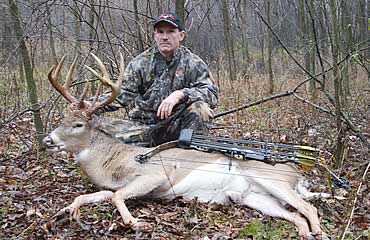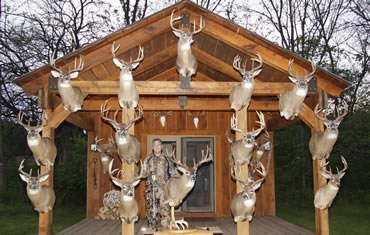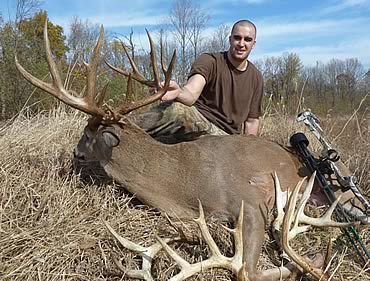Learn how these four bowhunters consistently tag trophies on small private properties and public land.
For three years, the Wisconsin giant taunted Dan Infalt from its strategically positioned bed under a willow tree in a relatively open area.
With each season, the buck grew bigger and smarter, constantly eluding Infalt while consistently bedding in the same area that kept it nearly untouchable, thanks to the open sight lines and prevailing west winds.
Then, on Thanksgiving of that third year, the avid bowhunter glassed the now 180-inch, 15-pointer in its bed, only this time the wind was out of the east.
Infalt promptly belly-crawled to within 15 yards and shot the brute. That buck, and dozens of other mature bucks he’s taken over the years, was on heavily hunted public land.
While television shows and magazines are filled with giant bucks shot on expansive, intensely managed private properties, savvy hunters can (and do) still find mature bucks on public land or even get access to private ground without paying a dime. You can, too.
THE BEDROOM PROWLER
Dan Infalt, Wisconsin
Track record: Two book-class bucks and more than 30 mature deer mounted on his walls (he’s stopped scoring bucks).
The 46-year-old public land expert focuses all of his scouting on one aspect of a deer’s behavior: bedding. Concentrating his efforts during March and April, Infalt finds bedding areas and, literally, analyzes the environment from a deer’s perspective.
“I’ll get down on my knees in a deer’s bed,” he says. “What can they see? What can they hear? Then I’ll set up where I’m just beyond their senses. It’s a game of inches. You go 10 feet too far and bust them out, or not far enough and you might never see them.”
With an abundance of lakes and marshes in his core hunting areas, Infalt has earned a reputation as a marsh hunting master. For new areas, he uses topo maps and aerial maps to target specific spots, and then walks the locations with maps in hand. Infalt focuses on fingers or points off marshes and islands that allow deer to easily detect danger. He then works backward to find travel routes into those bedding areas.
While he likes to get away from the crowd, Infalt is not intimidated by the sight of others in his hunting area. One of his best public land spots has an easily accessible parking lot. At one point, Infalt shot bucks five years in a row no more than 100 yards from the parking lot filled with vehicles.
“If I had three tips to give to hunters on public land, they would be bedding, bedding and bedding,” Infalt said.
“The biggest eye-opener for people, if they actually looked at beds, is that most bucks know you’re on the property before you even get to your stand.”
Infalt says too many public land hunters put too much emphasis on other elements like food sources or sign without considering proximity to bedding.
“If you’re hunting a rub line that’s nowhere near bedding, it’s not getting used in the daytime,” he said. “Instead of starting at the crop fields, I start at the bedding areas and work outward.”
 THE PRESSURE EVADER
THE PRESSURE EVADER
John Eberhart, Michigan
Track record: Twenty-five bucks in Michigan’s record book.
As one of the nation’s most hunted states, Michigan has little public ground not congested with hunters. So how has 62-year-old John Eberhart put more than two dozen bucks in the Commemorative Bucks of Michigan record book? By thinking like he’s being hunted.
“Where would you feel secure to get up and move in the daytime, knowing someone is trying to kill you?” Eberhart asks. “If I can walk to a location in an upright position, I will not hunt it. I limit myself to areas you need waders or a canoe to access, or where you must crawl on hands and knees.”
Eberhart, who frequently travels to Illinois and Kansas to hunt, still finds success asking for permission to hunt private property, focusing the bulk of his scouting in the late winter and early spring. That’s when he locates lone, centralized food sources, bedding areas and transition areas between them. That’s also when he hangs stands.
As a firm believer that bucks are most susceptible during the pre-rut, Eberhart stays out of his pre-rut stands until the time is right. That includes not placing or checking trail cameras around those setups.
“The vast majority of hunters scout a month or two before the season starts,” he said. “That makes bucks nocturnal before hunting even begins.”
Eberhart also recommends getting to stands at least 90 minutes before daylight to beat bucks returning to bedding or staging areas. And, whenever possible, he likes to stay all day. Eberhart has killed at least six bucks during the pre-rut between 10 a.m. and 2 p.m. as they moved from one bedding area to the next.
 THE HOTEL BUILDER
THE HOTEL BUILDER
Dan Nordstrom, Illinois
Track record: Two 200-class bowkills and several more record-book bucks.
As the owner of a couple of small parcels surrounded by heavily hunted properties, Dan Nordstrom of Coal Valley, Ill., must find ways to keep deer on his land. To do so, he looks to an unlikely place as a source of inspiration.
“I look at it like Las Vegas,” Nordstrom said. “There are hotels and restaurants everywhere. I want to have the best hotel and the best food for whitetails.”
To attract and keep deer, the 49-year-old creates bedding areas and destination food plots in the offseason. And he chooses sites carefully to dictate exactly where and how he wants the deer to travel.
He then takes extra precaution to avoid those bedding areas, instead hunting travel routes between them and other food sources. He particularly likes dog-leg setups where he can place a stand on either side of the elbow on a bend in the trail, depending on the wind.
And it’s no easy process. He says it takes him three to five years to really learn a property and its deer.
Like Eberhart, Nordstrom prefers the pre-rut because bucks are more predictable. During a pouring rain in the 2012 pre-rut, even though there was only an hour of daylight left, he knew he could slip undetected into one of his setups. Five minutes into his sit, Nordstrom put an arrow through a mature, 155-inch buck trailing a doe.
He says the biggest mistake hunters make is picking the wrong time to hunt. “I see a lot of hunters plan their vacation six months before, and they pick the wrong week and ruin their hunt,” Nordstrom said. “If you’re going after the alpha buck, he’s looking for the alpha doe. You have to get him on a pre-rut set or get lucky on a random set.”
 THE SHED SPECIALIST
THE SHED SPECIALIST
Luke Muldoon, Maryland
Track record: 188-, 163- and 198-inch bowkills in the past three years.
With three bucks in the past three years that would rival any hunter’s haul in the nation, Muldoon’s accomplishments belie his relative youth.
Hunting private and public ground in southern Maryland, the 24-year-old Air Force officer faces heavy hunting pressure on all of his ground, along with extremely high deer densities — not a good mix for finding a mature buck.
“I’ve found more than 100 sheds already this year, and not one would belong to a 150-inch buck,” Muldoon said.
Still, he spends countless hours each spring searching for sheds, saying they are an excellent indicator of a buck’s future patterns. Once Muldoon finds sheds from a buck worth hunting, he strategically scouts that buck until he’s figured it out.
The giants Muldoon shot over the past three years were the exact bucks he had targeted for those seasons.
He had been watching one of the bucks four years before finally targeting it for harvest.
With large white circles around its eyes, the deer was easily identifiable. He first saw it when it was a 1 1⁄2-year-old, basket-racked 8-pointer. The buck grew each year until wearing a world-class rack in 2012.
Due to work obligations, Muldoon had limited time to hunt, but he knew the buck’s core area. On Nov. 11, he bumped the buck when it was with a doe. Knowing the area and recognizing an odd wind shift, he moved to the other side of the woodlot and set up a stand. A few hours later, he arrowed the 198-incher.
Muldoon says hunters need to put more time and effort into the off season.
“If I had to give one piece of advice, I’d tell people to spend more time in the woods than anyone else,” he said. “That applies to any type of deer hobby — scouting, shed hunting, and hunting. Put in time, but be low-impact. I won’t shed hunt until I know antlers are down, and I won’t hunt a spot just to be out there. If the wind’s wrong, you aren’t going to shoot anything. Every time I go hunting, I have a specific purpose.”
DIFFERENT NOTES, SAME SONG
While these four bowhunters differ in their approach to hunting big bucks, one common factor is the amount of effort they put into being successful.
For them, hunting isn’t a three-month fall hobby. It’s a year-round dedication to discovering, learning and planning.
“It’s like anything you do in life,” Nordstrom says. “The more you understand your competition, the better you’re going to be. There’s no hocus-pocus. It’s putting in the work. There are no shortcuts if you want to consistently kill mature bucks.”
Read Recent Articles:
• Lunar or Loony? Does moon phase really affect deer activity?
• Drop Tine Blues: Nothing is more frustrating, or more rewarding, than hunting with a bow.
• A Day In The Life: White-tailed bucks lead a pretty mundane existence ... until the rut kicks in.
This article was published in the August 2013 edition of Buckmasters Whitetail Magazine. Subscribe today to have Buckmasters delivered to your home.